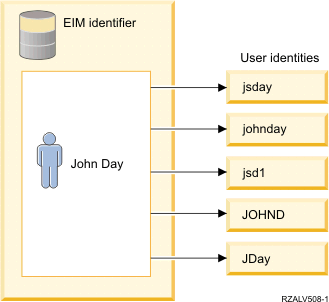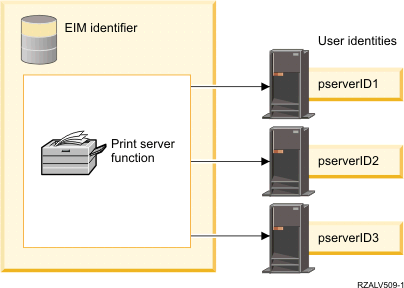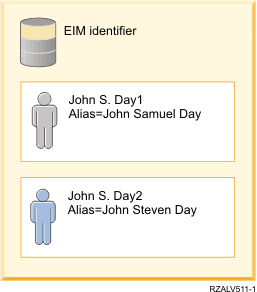EIM identifier
An Enterprise Identity Mapping (EIM) identifier represents a person or entity in an enterprise. A typical network consists of various hardware platforms and applications and their associated user registries. Most platforms and many applications use platform-specific or application-specific user registries. These user registries contain all of the user identification information for users who work with those servers or applications.
You can use EIM to create unique EIM identifiers for people or entities in your enterprise. You can then create identifier associations, or one-to-one identity mappings, between the EIM identifier and the various user identities for the person or entity that the EIM identifier represents. This process makes it easier to build heterogeneous, multiple-tier applications. It also becomes easier to build and use tools that simplify the administration involved with managing every user identity that a person or entity has within the enterprise.
EIM identifier representing a person
Figure 3 shows
an example of an EIM identifier that represents a person named John Day and
his various user identities in an enterprise. In this example, the person John
Day has five user identities in four different user registries: johnday, jsd1, JOHND, jsday, and JDay.
Figure 3: The relationship between the EIM identifier for John Day and his various user identities

In EIM, you can create associations that
define the relationships between the John Day identifier
and each of the different user identities for John Day. By creating
these associations to define these relationships, you and others can write
applications that use the EIM APIs to look up a needed, but unknown, user
identity based on a known user identity.
EIM identifier representing an entity
In addition
to representing users, EIM identifiers can represent entities within your
enterprise as Figure 4 illustrates. For example, often the print server function
in an enterprise runs on multiple systems. In Figure 4, the print server function
in the enterprise runs on three different systems under three different user
identities of pserverID1, pserverID2, and pserverID3.
Figure 4: The relationship between the EIM identifier that represents the print server function and the various user identities for that function

With EIM, you can create
a single identifier that represents the print server function within the entire
enterprise. As the example shows, the EIM identifier Print server
function represents the actual print server function entity in the
enterprise. Associations are created to define the relationships between the
EIM identifier (Print server function) and each of the user
identities for this function (pserverID1, pserverID2,
and pserverID3). These associations allow application developers
to use EIM lookup operations to find a specific print server function. Application
providers can then write distributed applications that manage the print server
function more easily across the enterprise.
EIM identifiers and aliasing
EIM identifier names must be unique within an EIM domain. Aliases can help address situations where using unique identifier names can be difficult. An example of the usefulness of EIM identifier aliases is in situations where someone's legal name is different from the name that person is known as. For example, different individuals within an enterprise can share the same name, which can be confusing if you are using proper names as EIM identifiers.
Figure 5 illustrates an
example in which an enterprise has two users named John S. Day. The
EIM administrator creates two different EIM identifiers to distinguish between
them: John S. Day1 and John S. Day2. However,
which John S. Day is represented by each of these identifiers is not
readily apparent.
Figure 5: Aliases for two EIM identifiers based on the shared proper name John S. Day

By using aliases, the
EIM administrator can provide additional information about the individual
for each EIM identifier. Each EIM identifier can have multiple aliases to
identify which John S. Day the EIM identifier represents. For example,
the additional aliases might contain each user's employee number, department
number, job title, or other distinguishing attribute. In this example, an
alias for John S. Day1 might be John Samuel Day and
an alias for John S. Day2 might be John Steven Day.
You
can use the alias information to aid in locating a specific EIM identifier.
For example, an application that uses EIM may specify an alias that it uses
to find the appropriate EIM identifier for the application. An administrator
can add this alias to an EIM identifier so that the application can use the
alias rather than the unique identifier name for EIM operations. An application
can specify this information when using the Get EIM Target Identities from
the Identifier (eimGetTargetFromIdentifier()) API to perform
an EIM lookup operation to find the appropriate user identity it needs.